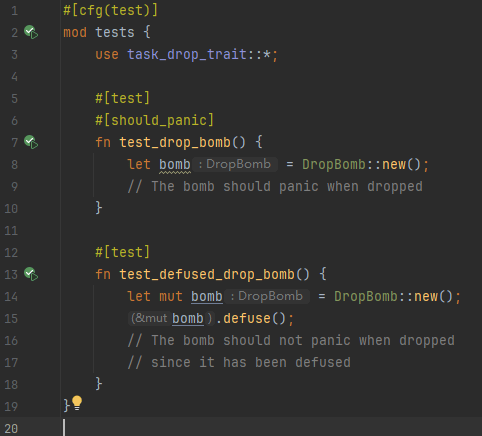31、The Drop trait
The Drop trait
在学析构函数的时候,提到了drop函数:
- 回收类型占用的内存(即
std::mem::size_ofbytes) - 清理值可能正在管理的任何其他资源(比如String的堆缓冲区)
第二点是Drop trait的用武之地
pub trait Drop {
fn drop(&mut self);
}
Drop trait是一种机制,用于为我们的类型定义其他的清理的逻辑,而不仅仅是编译器自动为我们做的事情。
当值超出它的作用域的时候,将执行我们drop方法里面的内容。
Drop and Copy
学到Copy trait时,提到过如果一个类型管理的资源超出了它在内存中占用的std::mem::size_of以外的其他资源时,则无法实现Copy。
话说编译器怎么知道一个类型是否管理额外的资源呢?其实就是Drop trait实现的。
如果我们的类型具有明确的Drop实现,编译器会认为我们的类型附加了额外的资源,不允许我们实现Copy。
// This is a unit struct, i.e. a struct with no fields.
#[derive(Clone, Copy)]
struct MyType;
impl Drop for MyType {
fn drop(&mut self) {
// We don't need to do anything here,
// it's enough to have an "empty" Drop implementation
}
}
编译器编译上面的代码就会报错:
error[E0184]: the trait `Copy` cannot be implemented for this type;
the type has a destructor
--> src/lib.rs:2:17
|
2 | #[derive(Clone, Copy)]
| ^^^^ `Copy` not allowed on types with destructors
即使我们的类型里什么也没有,只要有Drop实现,那么就绝对不能实现Copy了。
练习
感觉现在的练习读不懂题目,莫名其妙的,最后只好看答案,看完答案还是感觉莫名其妙:
// TODO: implement a so-called "Drop bomb": a type that panics when dropped
// unless a certain operation has been performed on it.
// You can see the expected API in the tests
//TODO:实现所谓的“Drop bomb”:一种Drop时Panic的类型
// 除非对其进行了某种操作。
// 您可以在测试中看到预期的 API
pub struct DropBomb {
defused: bool,
}
impl DropBomb {
pub fn new() -> Self {
DropBomb { defused: false }
}
pub fn defuse(&mut self) {
self.defused = true;
}
}
impl Drop for DropBomb {
fn drop(&mut self) {
if !self.defused {
panic!("Boom!");
}
}
}
为啥DropBomb要弄个bool类型啊

难道是我英语水平太差了吗?
阅读剩余
版权声明:
作者:CN059
链接:https://www.cn059.com/2025/09/15/31%e3%80%81.html
文章版权归作者所有,未经允许请勿转载。
THE END
